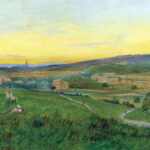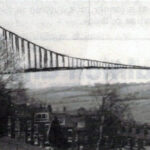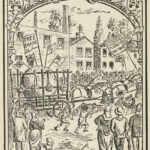11 June 1681: A recent grainstorm near Leeds
Ralph Thoresby. 1830. The Diary of Ralph Thoresby, F.R.S., Vol. 1. Ed. Joseph Hunter. London: Henry Colburn and Richard Bentley. Get it:
.Excerpt
Up at four, writing memoirs about the year 1544 till noon; then walked with Dutch cousin to Woodhouse Hill, where, in cousin Fenton’s best chamber, I gathered some of the corn that was rained down the chimney upon the Lord’s day seven-night, when it likewise rained plentifully of the like upon Headingley Moor, as was confidently reported. But those I gathered with my own hands from the white hearth, which was stained with drops of blue where it had fallen, for it is of a pale red or a kind of sky colour, is pretty, and tastes like common wheat, of which I have one hundred corns. What it may signify, and whether it doth proceed from natural causes (of which some may be prescribed) or preternatural, such an ignorant creature as I am cannot aver. [Probably (poisonous) ivy seed!]
Comment
Comment
Dated Saturday 11 June, so I guess “the Lord’s Day seven-night” (sennight) is Sunday 5 June rather than 29 May.
Via the editor’s notes to Abraham de la Pryme’s diary (Pryme 1870). Pryme himself mentions corn rain on 28 April 1687 in Lincolnshire, while editor Charles Jackson points to a similar report for 26 April 1661 in Spalding and Bourne (Lincs.) in Robert Burton’s Admirable curiosities (Crouch 1728), and notes an explanation in Jane Loudon’s British wild flowers:
The seeds of the ivy, when deprived of the pulpy matter which surrounds them, bear considerable resemblance to grains of wheat; and hence the numbers that are sometimes found lying about are supposed to have given rise to the stories of wheat being rained from the clouds, which were once so popular.
(Loudon 1846)
Something to say? Get in touch
Original
Up at four, writing memoirs about the year 1544 till noon; then walked with Dutch cousin to Woodhouse Hill; where, in Cousin Fenton’s best chamber, I gathered some of the corn that was rained down the chimney upon the Lord’s-day seven-night [presumably 5 June rather than 29 May], when it likewise rained plentifully of the like upon Headingley Moor, as was confidently reported; but those I gathered with my own hands from the white hearth, which was stained with drops of blue where it had fallen, for it is of a pale red or a kind of sky colour, is pretty, and tastes like common wheat, of which I have one hundred corns. What it may signify, and whether it doth proceed from natural causes, (of which some may be prescribed) or preternatural, such an ignorant creature as I am cannot aver.
143 words.
Similar
 26 May 1941: Headingley’s Shire Oak falls, legendary site of Anglo-Saxon local government between Aire and Wharfe
26 May 1941: Headingley’s Shire Oak falls, legendary site of Anglo-Saxon local government between Aire and Wharfe 30 May 1835: Alfred Austin, future poet laureate, “Banjo-Byron that twangs the strum-strum,” is born into rural splendour at Ashwood, 48 Headingley Lane, Leeds
30 May 1835: Alfred Austin, future poet laureate, “Banjo-Byron that twangs the strum-strum,” is born into rural splendour at Ashwood, 48 Headingley Lane, Leeds Reproduction through the blind benevolence of Leeds Other Paper (RIP).1 April 1979: Amid motorway mania in Leeds, West Yorkshire Council is today to reveal plans to link Chapeltown and Woodhouse by a ¼-mile suspension bridge across Meanwood Beck
Reproduction through the blind benevolence of Leeds Other Paper (RIP).1 April 1979: Amid motorway mania in Leeds, West Yorkshire Council is today to reveal plans to link Chapeltown and Woodhouse by a ¼-mile suspension bridge across Meanwood BeckSearch
Donate
Music & books
Place-People-Play: Childcare (and the Kazookestra) on the Headingley/Weetwood borders next to Meanwood Park.
Music from and about Yorkshire by Leeds's Singing Organ-Grinder.



 Bluesky
Bluesky Extwitter
Extwitter